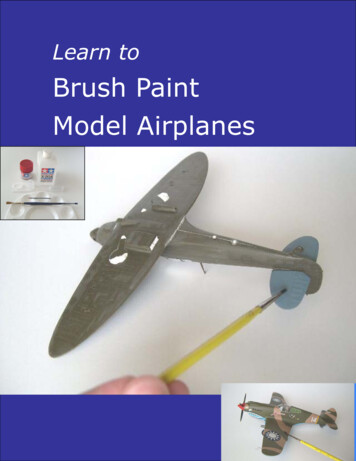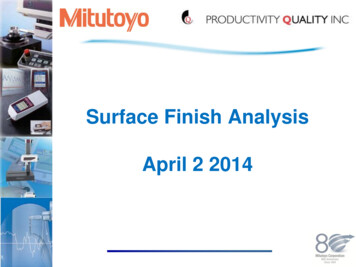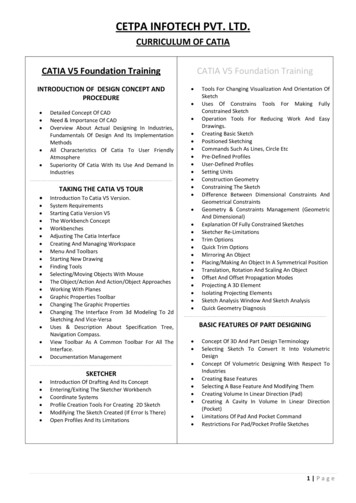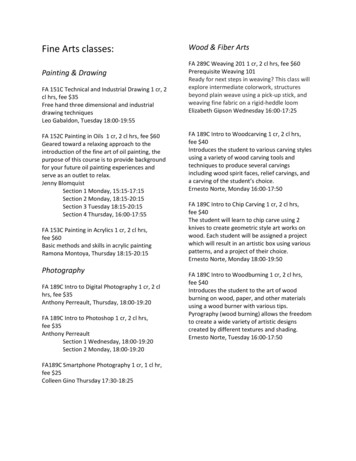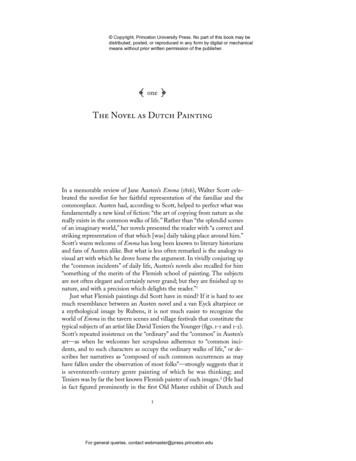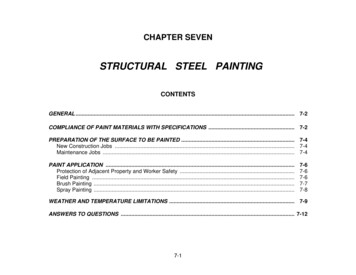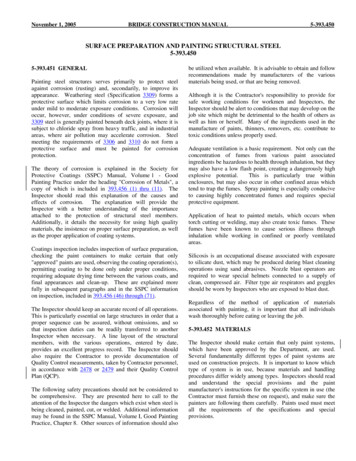
Transcription
November 1, 2005BRIDGE CONSTRUCTION MANUAL5-393.450SURFACE PREPARATION AND PAINTING STRUCTURAL STEEL5-393.4505-393.451 GENERALPainting steel structures serves primarily to protect steelagainst corrosion (rusting) and, secondarily, to improve itsappearance. Weathering steel (Specification 3309) forms aprotective surface which limits corrosion to a very low rateunder mild to moderate exposure conditions. Corrosion willoccur, however, under conditions of severe exposure, and3309 steel is generally painted beneath deck joints, where it issubject to chloride spray from heavy traffic, and in industrialareas, where air pollution may accelerate corrosion. Steelmeeting the requirements of 3306 and 3310 do not form aprotective surface and must be painted for corrosionprotection.The theory of corrosion is explained in the Society forProtective Coatings (SSPC) Manual, Volume 1 - GoodPainting Practice under the heading "Corrosion of Metals", acopy of which is included in 393.456 (1) thru (11). TheInspector should read this explanation of the causes andeffects of corrosion. The explanation will provide theInspector with a better understanding of the importanceattached to the protection of structural steel members.Additionally, it details the necessity for using high qualitymaterials, the insistence on proper surface preparation, as wellas the proper application of coating systems.Coatings inspection includes inspection of surface preparation,checking the paint containers to make certain that only"approved" paints are used, observing the coating operation(s),permitting coating to be done only under proper conditions,requiring adequate drying time between the various coats, andfinal appearances and clean-up. These are explained morefully in subsequent paragraphs and in the SSPC informationon inspection, included in 393.456 (46) through (71).The Inspector should keep an accurate record of all operations.This is particularly essential on large structures in order that aproper sequence can be assured, without omissions, and sothat inspection duties can be readily transferred to anotherInspector when necessary. A line layout of the structuralmembers, with the various operations, entered by date,provides an excellent progress record. The Inspector shouldalso require the Contractor to provide documentation ofQuality Control measurements, taken by Contractor personnel,in accordance with 2478 or 2479 and their Quality ControlPlan (QCP).The following safety precautions should not be considered tobe comprehensive. They are presented here to call to theattention of the Inspector the dangers which exist when steel isbeing cleaned, painted, cut, or welded. Additional informationmay be found in the SSPC Manual, Volume I, Good PaintingPractice, Chapter 8. Other sources of information should alsobe utilized when available. It is advisable to obtain and followrecommendations made by manufacturers of the variousmaterials being used, or that are being removed.Although it is the Contractor's responsibility to provide forsafe working conditions for workmen and Inspectors, theInspector should be alert to conditions that may develop on thejob site which might be detrimental to the health of others aswell as him or herself. Many of the ingredients used in themanufacture of paints, thinners, removers, etc. contribute totoxic conditions unless properly used.Adequate ventilation is a basic requirement. Not only can theconcentration of fumes from various paint associatedingredients be hazardous to health through inhalation, but theymay also have a low flash point, creating a dangerously highexplosive potential.This is particularly true withinenclosures, but may also occur in other confined areas whichtend to trap the fumes. Spray painting is especially conduciveto causing highly concentrated fumes and requires specialprotective equipment.Application of heat to painted metals, which occurs whentorch cutting or welding, may also create toxic fumes. Thesefumes have been known to cause serious illness throughinhalation while working in confined or poorly ventilatedareas.Silicosis is an occupational disease associated with exposureto silicate dust, which may be produced during blast cleaningoperations using sand abrasives. Nozzle blast operators arerequired to wear special helmets connected to a supply ofclean, compressed air. Filter type air respirators and gogglesshould be worn by Inspectors who are exposed to blast dust.Regardless of the method of application of materialsassociated with painting, it is important that all individualswash thoroughly before eating or leaving the job.5-393.452 MATERIALSThe Inspector should make certain that only paint systems,which have been approved by the Department, are used.Several fundamentally different types of paint systems areused on construction projects. It is important to know whichtype of system is in use, because materials and handlingprocedures differ widely among types. Inspectors should readand understand the special provisions and the paintmanufacturer's instructions for the specific system in use (theContractor must furnish these on request), and make sure thepainters are following them carefully. Paints used must meetall the requirements of the specifications and specialprovisions.
5-393.453BRIDGE CONSTRUCTION MANUALThe most common paint systems currently used on new steelbridge elements are zinc-rich primers (organic or inorganic)with an epoxy mid-coat and a urethane top coat. The mid-coatand top coat may also be applied over hot-dip galvanizingwith proper surface preparation. The primer, intermediate,and top coats shall be by the same manufacturer. Each of thepaints used in these systems consist of two or morecomponents that are mixed in limited batches just before use.Exact mixing of components is essential and the Contractor'sprocedures for mixing should be reviewed to verify thataccurate batching is achieved.Bridge elements may be delivered to the job site unpainted,with only the prime coat, or with a full shop paint system.Components that are fully shop painted may need to betouched up after erection due to shipping and handlingdamage. The plan and special provisions may also require thefasteners to be painted after installation. Components thathave only a shop-applied prime coat will be field painted withthe other coats as directed in the special provisions. Mostshop priming for later field top coating is done with aninorganic zinc-rich paint. Inorganic primers should not beapplied in the field. Handling damage shall be touched upwith organic epoxy zinc-rich primer prior to applying theremaining coats. All field painting requires the inspector toclosely monitor the procedures found in the paintmanufacturer's instructions and the special provisions.The organic zinc-rich primer system can be used where anSSPC-SP10-Near-White Blast Cleaning surface preparation orSSPC-SP6-Commercial Blast Cleaning, surface preparationhas been used. Only paint systems approved by Mn/DOTshall be used. If the Contractor wants to use an unapprovedpaint system, he must get written approval from the StructuralMetals Engineer.5-393.453 SURFACE PREPARATIONSurface preparation of structural steel members is undoubtedlythe most important step in obtaining maximum protectionagainst corrosion. Regardless of the quality of the paintsystem and the care exercised by the painters in applying thepaint, an improperly prepared surface will almost certainlyresult in an early paint failure, and will require costlymaintenance. Therefore, it is essential that a thoroughinspection be made of both painted and unpainted steelsurfaces immediately prior to starting painting.The Contractor can often eliminate considerable work byhosing down the steel under a deck slab during andimmediately after a deck pour, rather than waiting until thestart of painting. Fresh mortar can be easily flushed off, but itis usually difficult to remove after it has dried and hardened.In any event, the Inspector should make certain that thecleaning has been completed before painting is permitted onthese surfaces.November 1, 2005Foreign matter should be removed by means which will not bedetrimental to the steel, and which will not leave a residualfilm on the surface that cannot be wiped off. Regardless of thedegree of surface operations, grease and oil films should firstbe removed by the use of solvents or other effective methods.Solvents cover a wide range of materials, such as mineralspirits, naphtha, coal tar solvents, alcohols, ethers, mixedalcoholic-ether compounds, petroleum fractions and manyothers. Many solvents give off toxic fumes and requireadequate ventilation and other precautions during their use.The manufacturer's recommendations should be available, andshould be followed, whenever any of these materials are used.More detailed information on surface preparation, as well asother phases of painting, can be found in The Society forProtective Coatings Manual, Volume I, "Good PaintingPractice", which is available at the District Offices.All visible oil, grease, soil, drawing and cutting compoundsand other soluble contaminants should be removed fromsurfaces to be painted prior to hand tool cleaning, power toolcleaning, or blast cleaning. Heavy deposits should beremoved with a scraper followed by scrubbing or wiping withan appropriate cleaning solution. All visible traces ofcontaminants are to be removed with final wiping performedwith clean rags and clean solvent. A discussion of solventcleaning methods and Specification SSPC-SP1-"SolventCleaning" are included in Figure 5-393.456 (12) thru (13).Surfaces of steel members for which blast cleaning is specifiedmust be blasted in accordance with the requirements of thespecifications.Painting metal structures requires thatstructural steel members for superstructures be blast cleanedon those surfaces which are accessible for blast cleaning; andthat those surfaces of these members which are not accessibleshould be hand-tool cleaned. Blast cleaning should be inaccordance with SSPC-SP10-"Near White Blast Cleaning", acopy of which is included as 393.456 (26) thru (31)."Accessible surfaces" should be considered to mean thosesurfaces which would be accessible for blast cleaning in theerected structure, using conventional rigging.Specification 2479, for painting with inorganic zinc-rich paintsystems, requires that all surfaces to be prime coated shall beblast cleaned in accordance with SSPC-SP10. Prime coats arerequired for all contact surfaces including bolted splices,which must be blast cleaned and primed at the fabricator'sshop unless specific approval is obtained from the ProjectEngineer for field painting. If field painting is allowed, spliceplates and contact surfaces of steel diaphragms, "X" bracing,etc. must be blast cleaned and painted prior to erection asthese areas are not accessible in the erected position. Surfacepreparation meeting requirements of SSPC-SP10 is critical at
November 1, 2005BRIDGE CONSTRUCTION MANUALthe time of paint application for zinc-rich systems as thesepaints depend on intimate contact with bare steel to providegalvanic protection.A surface profile (roughness)requirement is frequently used for zinc-rich systems.The Special Provisions may require blast cleaning inaccordance with SSPC-SP6, unpainted 3309 steel. Blastcleaning is often required on bolted splice plates to improvefriction characteristics.Where uniform appearance ofunpainted steel is important, such as on fascia beams, blastcleaning may be required to promote uniform rusting andavoid a "spotty" appearance.Specification 1717 requires that the Contractor take necessaryprecautions to prevent pollution of flowing and impoundedwaters. It further requires compliance with all applicableregulations of the Minnesota Pollution Control Agency andMinnesota Department of Natural Resources. The SpecialProvisions will contain any specific requirements pertaining tothe project. Sand blasting and painting shall be done tominimize the escape of paint solvents, and cleaning solutionsinto public waters or the atmosphere. The primary emphasisshould be on containment within the project area rather thanon recovery systems such as floating booms, skimmers, etc.Paint chips and sand, if readily recoverable, are to be cleanedup and transported to a sanitary landfill.5-393.454 APPLICATION OF INDUSTRIALCOATINGSIncluded in 5-393.456 (31) thru (45) are copies of sections ofthe SSPC Manual dealing with the application of industrialcoatings. They are for the Inspector's information andguidance, and for his or her use, providing they are consistentwith Mn/DOT Specifications. The Specifications should befollowed in the event there is a discrepancy between theSpecifications and the SSPC.The various paint systems in use on bridge elements havesystem-specific requirements for application. To ensuresuccessful painting results, the painters must follow therequirements of temperature, humidity, surface preparationand cleanliness for each component of the paint system.These and other requirements are addressed in the paintmanufacturer's instructions, the Standard Specifications, andthe special provisions.For the zinc-rich systems (specification 2478), thespecifications require a technical representative of the paintmanufacturer to be on-site or on call during paint application.Inspectors should refer questions about the systemrequirements to this representative, preferably in a prepainting conference. An important area in which the technicalrepresentative can help the Inspector(s) is in recognizing aproperly prepared and cleaned surface.Intermediate coat & top coat paints may be applied directly toa galvanized surface after thorough cleaning and light sweep5-393.454blasting as per special provisions. Cleaning shall consist ofremoval of soil, cement mortar, and other surface dirt with astiff brush, scraper or other suitable tool. Oil or grease isremoved by wiping or scrubbing the surface with rags orbrushes wetted with a suitable solvent in accordance withSSPC-SP1-Solvent Cleaning [See 5-393.456 (12) thru (13)].A light sand blasting sufficient to roughen the surface shouldbe performed.Paint shall not be applied to metal surfaces when weatherconditions are unsatisfactory for the work or the conditionsinclude an air temperature below 4EC (40EF), metal surfacesless than 3EC (5EF) above the dew point, air that is misty, ormetal surfaces that are damp or frosted.Primer may be applied to rivet heads and to bolt heads andnuts during cold, dry weather, to preserve them againstcorrosion.These areas should be inspected prior tosubsequent coating. If any area is found to be defective, itshould be removed.Best results are usually obtained when painting is done duringdry, warm weather, with a light breeze. While the idealcombination of these conditions is desirable, it is notrealistically attainable insofar as specification requirementsare concerned.Whether it is to be applied at the fabricating plant orelsewhere, the prime coat must be applied immediately aftersurface preparation, usually the same day. Blast cleanedsurfaces, depending upon humidity conditions and the degreeof surface brightness of the steel, will develop surfacecorrosion almost immediately after cleaning. Therefore it isimperative that delays in starting prime coat painting beavoided. If delays are encountered in application of the primecoat, which permits "flash rust" to form on newly cleanedsteel, it is necessary to require additional cleaning to removethe newly formed rust.It is important that "touch up" areas, which are primed afterfield welding, be thoroughly cleaned by scrubbing andwashing with warm water. A mild (5 percent) solution ofphosphoric acid followed by water rinsing and drying mayalso be used.From the standpoint of protection against corrosion, the primecoat of paint is the most important of the several coats of paintapplied to the steel surfaces. It is particularly necessary thatspecial attention be given to its application. The dry filmthickness shall be in accordance with the manufacturer'sProduct Data Sheet (PDS).Special gages have been purchased and distributed to theDistricts for use by the painting Inspector(s). Diligent usageshould be made of these instruments to assure that the dry filmthickness (dft) of the primer coat has been met. It is importantthat the coverage be uniform, both in thickness andappearance, since poor workmanship in application of the
5-393.455BRIDGE CONSTRUCTION MANUALprime coat will be reflected in subsequent coats. Requiredthickness of paint may vary and specifications/specialprovisions should be consulted for each project.Small cracks and cavities between abutting or matingmembers or parts, which have not been sealed againstadmission of moisture prior to applying the second coat,should be filled with approved caulking before the finalapplication.November 1, 20052. Use of Magnetic Gagea. Hold the gage very steady against the steel to be tested.Any movement of the gage or vibration in the steel surfacewill yield readings that are too high.b. Rotate the gage dial in a counter-clockwise direction untilthe red probe goes to the down position and stays in thatposition as dial rotation is reversed.Spot coating of damaged areas is required prior to applicationof the finish coat. Damage may result from handling,shipping, erection, welding, bolting and/or falsework or formconstruction. Damaged areas should be cleaned, as necessary,to meet the surface preparation requirements for the type ofpaint system.c. Slowly, in a steady continuous motion, rotate the dial in aclockwise direction until magnetic contact is broken.Before applying any subsequent coat of paint, the previouscoat must be cured "to recoat" in accordance with themanufacturer's Product Data Sheet (PDS).Other types of gages are available from the Bridge Office,Office of Construction and Materials Engineering, and someDistrict Offices. Instructions for use of gages should beobtained and reviewed prior to their use.When it has been determined that the previous coat has cured"to recoat", the Inspector should make certain that the surfacesto be painted is first cleaned of dust, dirt, sand, and mortar,and all other foreign matter that may have come upon it sincethe previous coat was applied. Painting should not bepermitted when the wind velocity carries objectionableamounts of dust, sand, and debris. Dusty road surfaces in thearea may require treatment or occasional watering.The top coat shall not be started until after the deck slabconcrete has been placed, because of damage resulting fromform removal, mortar leakage, and other causes.The DFT shall be measured with a properly calibratedthickness gage in accordance with SSPC-PA2-measurement ofdry coating thickness with magnetic gages. If the coatingthickness cannot be satisfactorily determined, a destructivetest shall be used in accordance with 2478.3F1.1. Measuring DevicesVarious measuring devices are available for determining theDFT. [For additional information see 393.456 (61) through(67).]Rotating dial magnetic type gages are available at DistrictOffices for thickness measurements. This gage, whenproperly used, can be a valuable tool for measuring coatingthicknesses on magnetic steel. This gage is expensive andwarrants careful handling. Secure anchor cord prior to using.The rotation of the gage dial in a clockwise direction increasesspring tension against the magnetic force holding gate probe tothe steel. The thicker the paint coating the weaker themagnetic contact.d. Note dial reading, reverse dial and take a second reading.3. Other Gages4. Calibration Procedure for Thickness GagesWhile other procedures could be used, this procedure tends tocancel out gage errors and is recommended by the SteelStructures Painting Council.a. Correction Factor (after sandblasting and prior to painting).Use a 76 micron (3 mil) plastic shim, take thickness readingson each unpainted beam face at 3 locations. Take 3 readingsat each location (within a 6 inch circle). Subtract 76 microns(3 mils) from the thickness reading to obtain the correctionfactor for prime coat thickness measurements. The CorrectionFactor is an approximate measurement of the profile orroughness of the steel surface due to sandblasting.b. Repeat 4.a. using a 127 micron (5 mil) shim to determinecorrection factor for total paint thickness measurement.c. After the prime coat has been applied, take thicknessreadings at approximately the same locations measured in 4.a.(Without shim). Subtract prime-coat correction factor.d. After the required top-coats have been applied, repeatreadings and subtract correction factor for total paint thicknessmeasurement.e. Calibration - Periodic reading should be taken both withand without the above mentioned shims on a polished smoothsurface steel plate [minimum dimensions 75 mm (3 inches) x150 mm (6 inches) x 13 mm (1/2 inch]. This will assure thatthe gage has not changed its calibration.5-393.455 FINAL CLEANUP AND MISCELLANEOUSIt is the responsibility of the contractor to remove paint fromsurfaces which have become stained or blemished
November 1, 2005BRIDGE CONSTRUCTION MANUALby the painting operations. It is better to discuss this with thesuperintendent or foreman in advance of starting to paint, sothat he will be aware of the consequences of carelessness.Some areas such as slope paving, may be covered with tarps,plastic sheets, or other fabric, and thus prevent the need forextensive and difficult cleaning later. In most cases, properprecautions and painting procedures will minimize the amountof cleanup required, and will result in a neater looking job.Carelessness in paint application is also apt to create aproblem in public relations, as well as cause contamination ofleaf type vegetables, grasses, fruit trees, and pollution ofnearby waters. All practicable means should be used whichwould help avoid these problems, even to the extent ofchanging application methods when necessary.5-393.456 STEEL STRUCTURES PAINTING COUNCILEXCERPTSThe following pages are from SSPC Manual - Volume 1 "Good Painting Practice, Fourth Edition" and Volume 2 "Systems and Specifications, 2005 Edition" and are reprintedwith the written permission of the Society for ProtectiveCoatings, 40 24th Street, Pittsburgh, Pa. 15222, for theInspector's information and guidance.It should beunderstood, however, that recommendations made therein areenforceable only to the extent that they are consistent with theMn/DOT specifications which apply.Index to the Society of Protective Coatings Manuals excerptsCorrosion of Metals5-399.456 (1) thru (11)SSPC-SP 1 - Solvent Cleaning5-393.456 (12) thru (13)SSPC-SP 2 - Hand Tool Cleaning5-393.456 (14) thru (15)SSPC-SP 6/NACE No. 3 - Commercial Blast Cleaning5-393.456 (16) thru (20)SSPC-SP 7/NACE No. 4 - Brush-Off Blast Cleaning5-393.456 (21) thru (25)SSPC-SP 10/NACE No. 2 - Near-White Blast Cleaning5-393.456 (26) thru (30)Application of Industrial Coatings5-393.456 (31) thru (45)Inspection5-393.456 (46) thru (71)5-393.456
5-393.456 (1)BRIDGE CONSTRUCTION MANUALNovember 1, 2005Chapter 1.1Corrosion of MetalsJames F. Jenkins and Richard W. DriskoIntroductionThis chapter describes in basic terms thecauses and mechanisms of corrosion. Corrosion isdefined as “the chemical or electrochemical reactionbetween a metal and its environment resulting in theloss of the material and its properties.” 1 Various typesof corrosion are discussed and the basic principlesbehind the use of protective coatings and cathodicprotection for corrosion control are also covered. Thestrategies used in corrosion control by design arebriefly discussed as well. This basic knowledge helpsin understanding how protective coatings, cathodicprotection, and other corrosion control methods canbest be used as part of a total corrosion controlprogram. Further information on these corrosioncontrol methods can be found in subsequent chapters.and strength. Rust is also unsightly and can causecontamination of the environment and industrialproducts. It is further detrimental in that it is not astable base for coatings.Why Metals CorrodeWith few exceptions, metallic elements arefound in nature in chemical combination with otherelements. For example, iron is usually found in naturein the form of an ore, such as iron oxide. This combined form has a low chemical energy content and isvery stable. Iron can be produced from iron ore by ahigh temperature smelting process. The heat that isadded during smelting breaks the chemical bondbetween the iron and the oxygen. As a result, the ironand other metals used in structural applications have ahigher energy content than they do in their originalstate, and are relatively unstable.Corrosion is a natural process. Just like waterflows to seek the lowest level, all natural processestend towards the lowest possible energy states. Thus,iron and steel have a natural tendency to combine withother chemical elements to return to their lower energystates. In order to do this, iron and steel will frequentlycombine with oxygen, present in most natural environments, to form iron oxides, or “rust,” similar chemicallyto the original iron ore. Figure 1 illustrates this cycle ofrefining and corrosion of iron and steel.When rust forms on an iron or steel structure,metal is lost from the surface, reducing cross sectionFigure 1. The corrosion cycle.Immunity and PassivitySome metals such as gold and platinum havelower energy levels in their metallic form than whencombined with other chemical elements. These metalsare often found in nature in the metallic form and donot tend to combine with other elements. They arethus highly resistant to corrosion in most naturalenvironments. These materials are said to be immuneto corrosion in those natural environments.Other metals and alloys, while in a highenergy state in their metallic forms, are resistant tocorrosion due to formation of passive films (usuallyoxides) on their surfaces. These films form through anatural process similar to corrosion, and are usuallyinvisible to the naked eye. They are, however, tightlyadherent and continuous and serve as a barrierbetween the underlying metal and the environment.Stainless steels, aluminum alloys, and titanium areexamples of metals that are in a high energy state intheir metallic forms, but are relatively resistant tocorrosion due to the formation of passive films on theirsurfaces. However, particularly in the case of stainless
November 1, 2005BRIDGE CONSTRUCTION MANUALsteels and aluminum alloys, this film is not resistant toall natural environments and can break down in one ormore particular environments. This breakdown of thepassive film often results in rapid, localized corrosion,due to the electrochemical activity of the parts of thesurface that remain passive. Figure 2 shows anexample of such rapid, localized corrosion. (Note: Thistype of rapid, localized corrosion does not occur whenpaint coatings break down. Although paints provide asimilar type of protection to the underlying metal, theyare usually not electrochemically active.)5-393.456 (2)where Mo is a neutral metal atom, M is a positivelycharged metal ion, and e- is an electron. Corrosionoccurs as the positively charged ions enter the electrolyte and are thus effectively removed from the metalanode surface. The electrons remain in the bulk metaland can move through the metal to complete otherreactions. In the case of iron (Fe) two electrons areusually lost, and the equation is:Feo 6 Fe 2 ewhere Feo is an iron atom and Fe is an iron (ferrous)ion. After the iron ions (Fe ) enter the electrolyte, theyusually combine with oxygen in a series of reactionsthat ultimately form rust.Figure 2. Corroded low-alloy steel bridge where protective outside film has been lost.The Mechanism of CorrosionThe combination of metals with other chemicalelements in the environment—what is commonlycalled corrosion—occurs through the action of theelectrochemical cell. The electrochemical cell consistsof four components: an anode, a cathode, an electrolyte, and a metallic path for the flow of electrons.When all four of these components are present asshown in Figure 3 “cyclic reaction” occurs that resultsin corro- sion at the anode.The key to understanding corrosion andcorrosion control is that all of the components of thiselectrochemical cell must be present and active forcorrosion to occur. If any one of the components ismissing or inactive, corrosion will be arrested.AnodeAt the anode in an electrochemical cell, metalatoms at the surface lose one or more electrons andbecome positively charged ions. The generic chemicalequation for this type of reaction is:Mo6M e-Figure 3. The basic components of the electrochemicalcell.CathodeAt the surface of the cathode in an electrochemical cell, the electrons produced by the reactionsat the anode are “consumed,” i.e., used up by chemical reactions. The generic chemical equation for thistype of reaction is:R e- 6 RoorRo e- 6 RIn this equation, R stands for any of a numberof possible compounds that can exist in an oxidizedform (R ) and in a reduced form (Ro).Many cathodic reactions are possible in
5-393.456 (3)BRIDGE CONSTRUCTION MANUALnatural environments. The cathodic reactions thatactually occur are dependent on the chemical composition of the electrolyte. In many instances where theelectrolyte is water, the cathodic reaction is:2H2O O2 4e64OHIn this reaction, two water molecules (H2O)combine with one oxygen molecule (O2) and fourelectrons to form four hydroxide ions (OH-). In thiscase, the water and oxygen are reduced as in thegeneric cathodic reaction above. These hydroxide ionstend to create an alkaline environment at activecathodic areas.Metallic PathA metallic path between the anode and thecathode allows electrons produced at the anode toflow to the cathode. A metallic path is required in thecorrosion cell because the elec
other phases of painting, can be found in The Society for Protective Coatings Manual, Volume I, "Good Painting Practice", which is available at the District Offices. All visible oil, grease, soil, drawing and cutting compounds and other soluble contaminants should be removed from surfa


